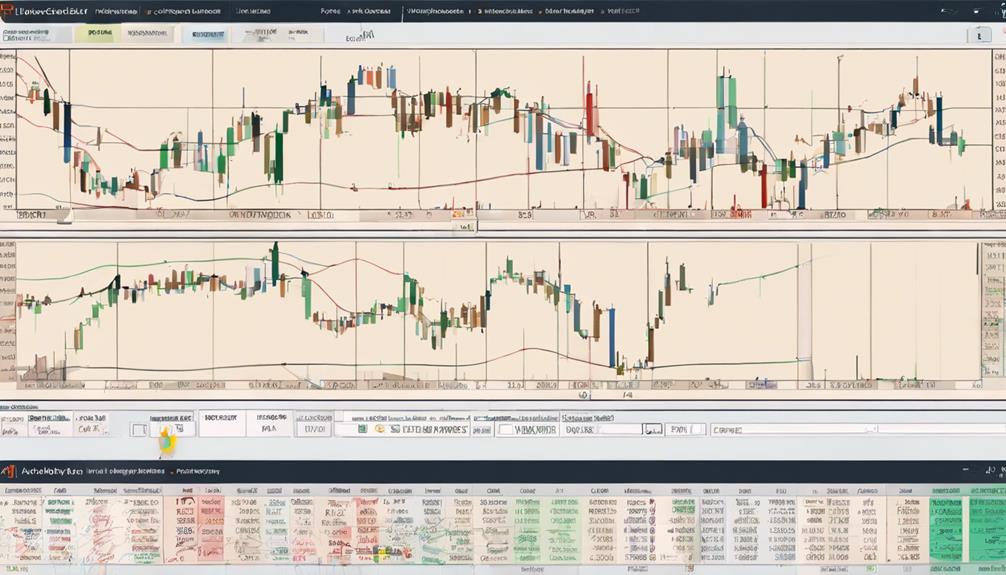Exploring the intricacies of mastering volatility indicators offers a nuanced understanding of market dynamics and trading strategies.
From navigating the nuances of Implied Volatility to harnessing the power of Bollinger Bands, each indicator presents a unique lens through which traders can interpret market behavior.
As we delve into the realm of volatility indicators, a deeper insight awaits those keen on unraveling the complexities of market volatility and unlocking the potential for informed decision-making.
Volatility Indicator Basics
In the realm of financial markets, a fundamental aspect that traders rely on for assessing market dynamics and potential risks is understanding the basics of volatility indicators. These indicators, such as Bollinger Bands, Average True Range (ATR), and the Volatility Index (VIX), play a crucial role in measuring market volatility and price fluctuations. Price volatility, influenced by market conditions, can significantly impact trading strategies and risk management approaches.
The Average True Range (ATR) indicator measures market volatility by considering the range between the high and low prices on a given trading day. Bollinger Bands, on the other hand, consist of a moving average line and two standard deviation lines, helping traders identify potential price breakouts and reversals. The Volatility Index (VIX) reflects market expectations of near-term volatility, providing insights into investor sentiment and potential market trends.
Utilizing these volatility indicators effectively can enhance decision-making processes and aid in developing robust risk management strategies for traders navigating the ever-changing financial markets.
Choosing the Right Indicator

Selecting the appropriate volatility indicator entails a meticulous assessment of market conditions, trading strategies, and the specific characteristics of each indicator. When choosing the right indicator, it's crucial to consider the volatility measurement method it utilizes.
For instance, the Moving Average is commonly used to smooth out price movements and identify trends, while the True Range (ATR) focuses on the trading range over a specified period.
Traders interested in overall market volatility might look into the Volatility Index (VIX) or implied volatility. High volatility environments may call for indicators that signal Upper or Lower price levels, indicating potential reversal points.
To make an informed decision, evaluate the indicator's historical performance, sensitivity to market changes, and alignment with your risk tolerance. Experimenting with different indicators can help you find the most suitable one for your volatility trading strategy, ensuring it complements your trading goals and overall market analysis approach.
Interpreting Indicator Signals

When analyzing volatility indicators, a key aspect lies in accurately interpreting the signals they generate to make informed trading decisions based on market conditions and trend movements. Understanding the nuances of these indicators is crucial for successful trading. Here are some key points to consider:
- Bollinger Bands Signals: Expanding Bollinger Bands indicate an increase in volatility, while contracting bands suggest decreasing volatility.
- ADX Signals: ADX values above 25 signal a trending market, whereas values below 20 indicate a ranging or consolidating market.
- ATR Values: Higher Average True Range (ATR) values signify greater volatility, whereas lower values imply a calmer market environment.
- ADX Peaks: Declining ADX peaks can indicate potential market consolidation or a trend reversal.
Implementing Indicator Strategies

Implementing effective indicator strategies requires a comprehensive understanding of key volatility indicators like Bollinger Bands, ADX, and ATR to navigate and interpret market conditions successfully. These indicators play a crucial role in formulating trading strategies, especially when volatility is high.
For instance, traders can utilize Bollinger Bands to identify potential market transitions and adjust their options trading strategy accordingly. When ADX crosses certain levels, it can signal the beginning or end of a trend, providing valuable insights for adjusting trading approaches. Additionally, incorporating ATR into trading strategies can help traders assess the potential risks and rewards based on the assets' price volatility.
Fine-Tuning Your Approach

To enhance trading strategies effectively, refining the parameters of volatility indicators is essential for optimizing market analysis and adapting to varying market conditions and timeframes. Fine-tuning your approach involves the following key steps:
- Experiment with Different Settings: Understanding how adjustments to parameters like indicator periods and standard deviations impact indicators such as Bollinger Bands can provide valuable insights into market dynamics.
- Adapt to Changing Market Conditions: Tweaking indicator settings allows for flexibility in analyzing different market environments, such as periods of increased volatility or when market movements are more subdued.
- Combine Indicators for Comprehensive Analysis: Exploring unique combinations of indicators can offer a holistic view of volatility and price action, enhancing your ability to identify market trends and opportunities effectively.
- Regularly Review and Adjust: Continuously monitor and adjust indicator settings based on market feedback to fine-tune your approach and take advantage of evolving market conditions for better decision-making.
What Is the Best Approach for Mastering Volatility Indicators for Profit?
When it comes to understanding volatility indicators for profit, the best approach is to start with a solid education on the subject. Learn to interpret the various indicators and understand their significance in different market conditions. Practice applying this knowledge in simulated trading scenarios to gain confidence in your ability to profit from volatility indicators.
Frequently Asked Questions
How Do You Use Volatility Indicators?
Volatility indicators, such as Bollinger Bands and Average True Range, are utilized by traders to assess market volatility, predict price movements, and identify potential trends. Traders should integrate these indicators cautiously to avoid misinterpretation and optimize trading strategies.
What Is the Best Strategy for Volatility Index?
The best strategy for the volatility index involves utilizing options strategies like Straddle or Iron Condor to leverage market volatility. Key indicators such as Implied Volatility (IV) and Historical Volatility (HV) are crucial in determining optimal approaches.
What Is the Standard Approach to Estimating Volatility?
The standard approach to estimating volatility involves utilizing indicators like Average True Range (ATR), Bollinger Bands, analyzing historical price movements, Implied Volatility (IV) from options prices, and measuring dispersion with standard deviation to gauge market expectations and past fluctuations.
What Is the Best Options Strategy for Volatility?
The best options strategy for volatility depends on market conditions. In high volatility, the Straddle Strategy, combining call and put options, can be effective. During low volatility, the Iron Condor strategy, utilizing ATR and Bollinger Bands, may yield better results.
Conclusion
In conclusion, mastering volatility indicators is crucial for successful trading strategies.
By utilizing key indicators such as Implied Volatility, Historical Volatility, and Bollinger Bands, traders can effectively measure market volatility levels and adapt their approaches accordingly.
One interesting statistic to note is that options traders often use the Average True Range (ATR) to determine potential price movement, with studies showing that incorporating ATR into trading strategies can lead to improved risk management and profitability.
